The GIGABYTE Aorus AX370-Gaming 5 Review: Dual Audio Codecs
by Gavin Bonshor on November 14, 2017 12:30 PM ESTSystem Performance
Not all motherboards are created equal. On the face of it, they should all perform the same and differ only in the functionality they provide - however, this is not the case. The obvious pointers are power consumption, but also the ability for the manufacturer to optimize USB speed, audio quality (based on audio codec), POST time and latency. This can come down to manufacturing process and prowess, so these are tested.
Power Consumption
Power consumption was tested on the system while in a single ASUS GTX 980 GPU configuration with a wall meter connected to the Thermaltake 1200W power supply. This power supply has ~75% efficiency > 50W, and 90%+ efficiency at 250W, suitable for both idle and multi-GPU loading. This method of power reading allows us to compare the power management of the UEFI and the board to supply components with power under load, and includes typical PSU losses due to efficiency. These are the real world values that consumers may expect from a typical system (minus the monitor) using this motherboard.
While this method for power measurement may not be ideal, and you feel these numbers are not representative due to the high wattage power supply being used (we use the same PSU to remain consistent over a series of reviews, and the fact that some boards on our test bed get tested with three or four high powered GPUs), the important point to take away is the relationship between the numbers. These boards are all under the same conditions, and thus the differences between them should be easy to spot.
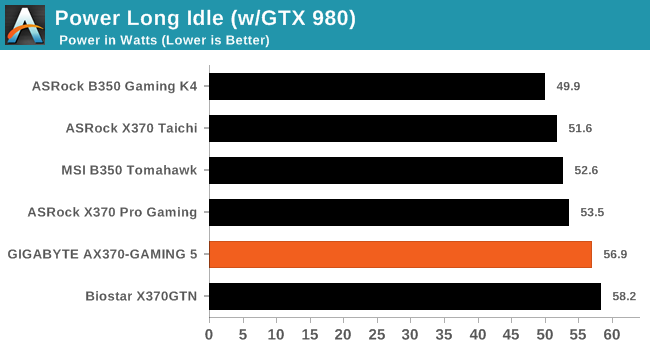
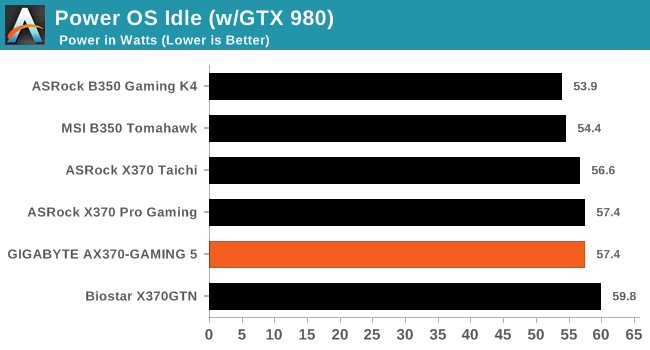
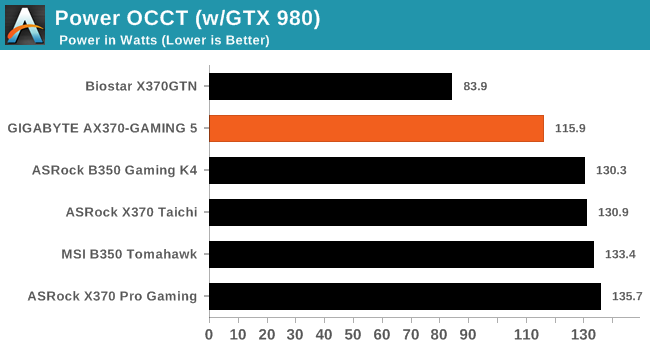
The idle power consumption numbers for the Gaming 5 were slightly higher than most of the boards, likely due to the use of dual network controllers and the additional USB 3.1 controller, not to mention all the LED lighting. That being said, under load, it used 15W less power than the other full-sized motherboards. We are still trying to narrow down exactly what is the cause, in case something isn't firing up properly. Nonetheless, nothing was untoward in our benchmarking.
Non-UEFI POST Time
Different motherboards have different POST sequences before an operating system is initialized. A lot of this is dependent on the board itself, and POST boot time is determined by the controllers on board (and the sequence of how those extras are organized). As part of our testing, we look at the POST Boot Time using a stopwatch. This is the time from pressing the ON button on the computer to when Windows starts loading. (We discount Windows loading as it is highly variable given Windows specific features.)
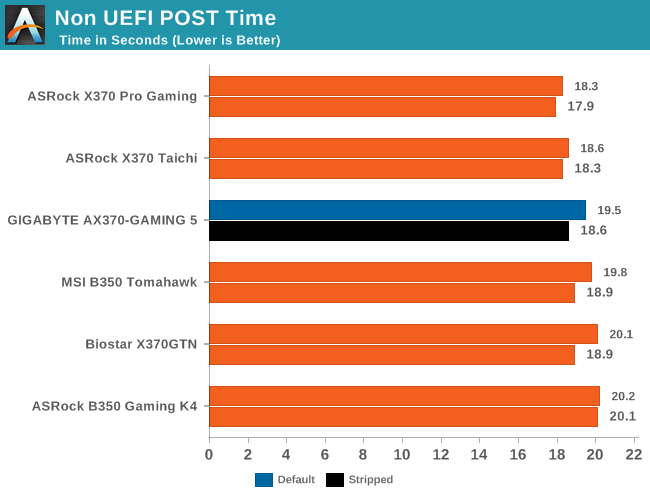
Most of the POST times on X370 seem to be in the same ball-park, differing by a second or two.
Rightmark Audio Analyzer 6.2.5
Rightmark:AA indicates how well the sound system is built and isolated from electrical interference (either internally or externally). For this test we connect the Line Out to the Line In using a short six inch 3.5mm to 3.5mm high-quality jack, turn the OS speaker volume to 100%, and run the Rightmark default test suite at 192 kHz, 24-bit. The OS is tuned to 192 kHz/24-bit input and output, and the Line-In volume is adjusted until we have the best RMAA value in the mini-pretest. We look specifically at the Dynamic Range of the audio codec used on the rear panel of the board.
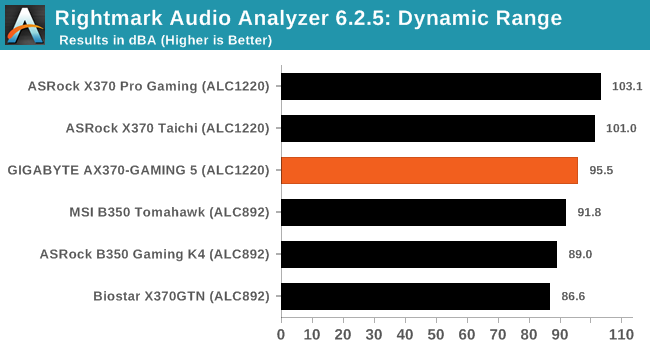
One of the downsides of using dual audio codecs is that the space that is normally dedicated for one now has to be split between two. The ALC1220 easily beats the ALC892 solutions, however.
DPC Latency
Deferred Procedure Call latency is a way in which Windows handles interrupt servicing. In order to wait for a processor to acknowledge the request, the system will queue all interrupt requests by priority. Critical interrupts will be handled as soon as possible, whereas lesser priority requests such as audio will be further down the line. If the audio device requires data, it will have to wait until the request is processed before the buffer is filled.
If the device drivers of higher priority components in a system are poorly implemented, this can cause delays in request scheduling and process time. This can lead to an empty audio buffer and characteristic audible pauses, pops and clicks. The DPC latency checker measures how much time is taken processing DPCs from driver invocation. The lower the value will result in better audio transfer at smaller buffer sizes. Results are measured in microseconds.
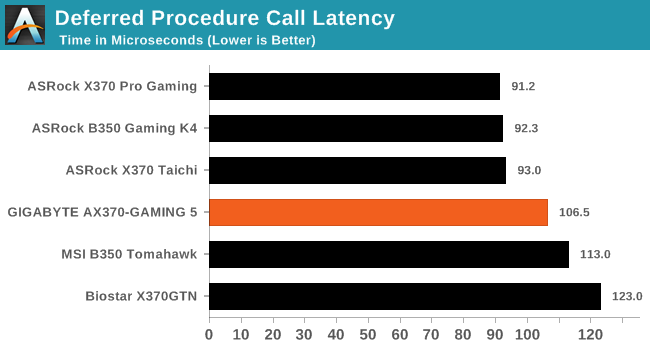
All of our X370 boards get under a nice 150 microseconds, although the ASRock boards seem to do well here. The Gaming 5 doesn't match them but is the next one behind.










34 Comments
View All Comments
Samus - Wednesday, November 15, 2017 - link
True, but the problem is most of the DAC's have a lower overall quality than many high end onboard DAC's. Especially wireless headphones. Until I found the SteelSeries H (Now the Siberia I guess...) I had pretty much given up finding wireless headphones with a decent DAC.PeachNCream - Tuesday, November 14, 2017 - link
Killer NIC... *sad panda*Flunk - Tuesday, November 14, 2017 - link
Only an issue if you want two Ethernet ports, there is also an Intel NIC on there.wolrah - Tuesday, November 14, 2017 - link
@Flunk that doesn't excuse it, that makes it worse. They clearly understand that Intel NICs are better, but they only half-assed it. Killer is gimmicky garbage. It needs to go away.The only non-Intel network card I want to see on a motherboard is one of the NBaseT products, and only because Intel doesn't yet make one.
DanNeely - Wednesday, November 15, 2017 - link
No, it means they clearly understand the market. Of the people who care about the nic brand, half have drank killer's koolaid and know it makes them game better, and half know that intel's the way to go because their drivers are much less garbage than the competition. This lets them supply both of the main halves of the care about nic brand market. The group of people who care about nic brand and need 2 of them is much smaller; losing them and/or sending them to a different model in the lineup isn't a major loss.PeachNCream - Thursday, November 16, 2017 - link
Does Qualcomm still own the Killer NIC brand? I thought that was their product operating under a subsidiary.nismotigerwvu - Tuesday, November 14, 2017 - link
There's a typo on your conclusions page. It should read "gigabit ethernet" not "gigabyte ethernet".Dr. Swag - Tuesday, November 14, 2017 - link
Could you guys add some more in depth vrm stuff into the mix? Like current capabilites, vrm temp measurements, etc. A lot of AM4 boards have sub par VRMs that don't have proper temp protections and stuff, so it would be really nice if you guys could add some stuff that looks into this sort of stuff.Horza - Tuesday, November 14, 2017 - link
The VRM information is incorrect as far as I know. It's running in 6+2 mode with, as you said, doublers on the SOC VRM so it's 6+(2x2) not 8+2.Cooe - Saturday, March 24, 2018 - link
This is correct. The flagship K7 also uses the exact same 6+(2x2) VRM setup (in addition to everything else aside from it's inclusion of a external BCLK generator & additional LED strip on the I/O shield).